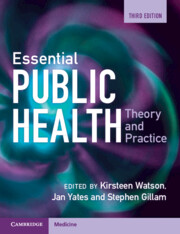Book contents
- Essential Public Health
- Essential Public Health
- Copyright page
- Contents
- Contributors
- Foreword
- Acknowledgements
- Introduction
- Part 1 The Public Health Toolkit
- Part 2 Contexts for Public Health Practice
- Introduction to Part 2: What Do We Mean by Contexts in Public Health?
- 11 The Health of Children and Young People
- 12 Adult Public Health and Non-Communicable Diseases
- 13 Public Health and Ageing
- 14 Health Inequalities and Public Health Practice
- 15 Health Policy
- 16 International Development and Public Health
- 17 Planetary Health
- Glossary
- Index
- References
14 - Health Inequalities and Public Health Practice
from Part 2 - Contexts for Public Health Practice
Published online by Cambridge University Press: 01 December 2023
- Essential Public Health
- Essential Public Health
- Copyright page
- Contents
- Contributors
- Foreword
- Acknowledgements
- Introduction
- Part 1 The Public Health Toolkit
- Part 2 Contexts for Public Health Practice
- Introduction to Part 2: What Do We Mean by Contexts in Public Health?
- 11 The Health of Children and Young People
- 12 Adult Public Health and Non-Communicable Diseases
- 13 Public Health and Ageing
- 14 Health Inequalities and Public Health Practice
- 15 Health Policy
- 16 International Development and Public Health
- 17 Planetary Health
- Glossary
- Index
- References
Summary
That differences in health outcomes exist between groups is unsurprising and, in some cases, seems subject to ‘natural law’. Such ‘common sense’, arguably unavoidable differences are termed ‘health disparities’ – a term usually understood to be value-neutral. By contrast, more complex differences in health outcomes which seem to derive from differences in opportunities or systemic bias are deemed ‘unfair’ and are referred to as ‘health inequalities’ or ‘health inequities’.
This chapter delves further into how we describe health inequalities and different measures and data that illustrate these differences. Causes and mechanisms of inequality are explored, followed by examples of inequality across groups with certain population characteristics, including ethnicity; gender, sexual orientation and gender identity; disability; and socially excluded groups. Finally, approaches and strategies for reducing health inequalities are presented, with potential actions described at the micro-, meso- and macro-levels.
Keywords
- Type
- Chapter
- Information
- Essential Public HealthTheory and Practice, pp. 265 - 289Publisher: Cambridge University PressPrint publication year: 2023



